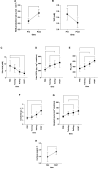Oxidative stress and motion sickness in one crew during competitive offshore sailing
- PMID: 35064225
- PMCID: PMC8782845
- DOI: 10.1038/s41598-022-05219-6
Oxidative stress and motion sickness in one crew during competitive offshore sailing
Abstract
Competitive Offshore Ocean Sailing is a highly demanding activity in which subjects are exposed to psychophysical stressors for a long time. To better define the physiological adaptations, we investigated the stress response of subjects exposed to 3-days long ocean navigation with disruption of circadian rhythms. 6 male subjects were involved in the study and provided urine and saliva samples before setting sail, during a single day of inshore sailing, during 3-days long ocean navigation, and at the arrival, to measure oxidative stress, cortisol, nitric oxide metabolites (NOx) and metabolic response. Motion Sickness questionnaires were also administered during the navigation. The crew suffered a mean weight loss of 1.58 kg. After the long navigation, a significant increase in ROS production and decrease in total antioxidant capacity and uric acid levels were observed. Lipid peroxidation, NO metabolites, ketones, creatinine, and neopterin levels were also increased. Furthermore, a significant increase in cortisol levels was measured. Finally, we found a correlation between motion sickness questionnaires with the increase of NOx, and no correlation with cortisol levels. Physical and psychological stress response derived from offshore sailing resulted in increased oxidative stress, nitric oxide metabolites, and cortisol levels, unbalanced redox status, transient renal function impairment, and ketosis. A direct correlation between motion sickness symptoms evaluated through questionnaires and NOx levels was also found.
© 2022. The Author(s).
Conflict of interest statement
The authors declare no competing interests.
Figures



References
-
- Myers SD, Leamon SM, Nevola VR, Llewellyn MGL. Energy expenditure during a single-handed transatlantic yacht race. Br. J. Sports Med. 2008;42(4):285–288. - PubMed
-
- Fearnley D, Sutton L, O’Hara J, Brightmore A, King R, Cooke C. Case study of a female ocean racer: Prerace preparation and nutritional intake during the Vendée Globe 2008. Int. J. Sport Nutr. Exerc. Metab. 2012;22(3):212–219. - PubMed
-
- Bigard A, Guillemot PCJY. Nutrient intake of elite sailors during a solitary long-distance offshore race. Int. J. Sport Nutr. 1998;8:364–376. - PubMed
Publication types
MeSH terms
Substances
LinkOut - more resources
Full Text Sources
Medical

